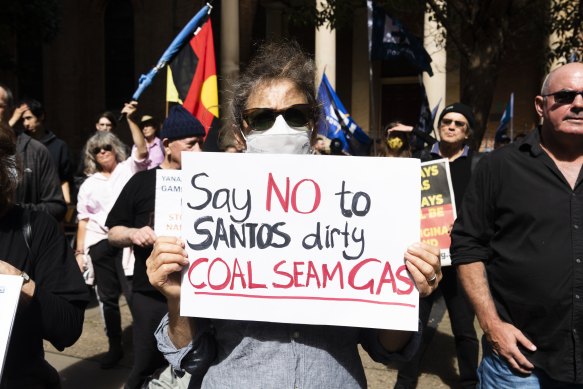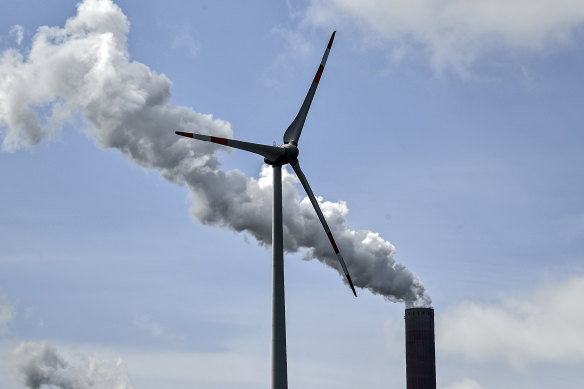This was published 2 years ago
Coal, gas to smooth transition to clean power: Top energy officials
By David Crowe and Mike Foley
States will gain the right to decide whether coal and gas will be part of a national scheme to reward power generators who can meet the urgent need for new electricity supplies, with the peak energy regulator saying Australia must build 50 times the capacity of the original Snowy Hydro scheme by 2050.
The dramatic call will clear the way for NSW to include gas in the new “capacity mechanism” in the hope of developing the Narrabri coal seam gas field in the north of the state, while Victoria could insist on keeping coal and gas out of the scheme in favour of renewable energy.

An anti-Santos rally in Sydney in April.Credit: Rhett Wyman
The Energy Security Board will unveil the draft plan on Monday with options for every jurisdiction to go its own way on the subsidies to be offered to generators who can guarantee capacity in the national electricity market after the shock to supply and prices this winter.
But the draft plan does not say how much the payments would be worth to generators, how much consumers would have to pay through their energy bills, when the scheme would start or how each jurisdiction would impose unique rules on each section of the east coast electricity grid.
In a finding that sets up hard decisions for state and federal political leaders, the Energy Security Board says it would be better to include existing power generation in the scheme – including gas and coal – and says “all capacity types” should be allowed to bid to guarantee supply.
Energy Minister Chris Bowen has not said whether the rewards for guaranteed supply should be extended to power stations using coal or gas, while Victorian counterpart Lily D’Ambrosio wants the benefits to be restricted to renewable providers.
“The necessary scale of investment to maintain reliability over the coming decades is dramatic.”
Energy Security Board
NSW Treasurer and Energy Minister Matt Kean backs a model based on the state’s electricity infrastructure roadmap, which bars coal but could include gas, when the government wants coal seam gas to flow from Narrabri from 2026 with none of the volume going to exports.
The Energy Security Board, the peak group of national energy regulators, sets out its draft model in the hope of security agreement from state and federal ministers by February so new electricity generation can be built to meet demand.
“The necessary scale of investment to maintain reliability over the coming decades is dramatic,” the new report says.
“The new capacity required over the next 28 years is more than seven times that built over a similar time frame since the NEM commenced 24 years ago and around fifty times the amount built by the Snowy Hydroelectric Scheme.”
The report warns that coal-fired generators account for more than half the national electricity grid but are reaching the end of their technical lives when electricity demand could at least double by 2050.

State and federal energy ministers will meet to discuss the design of a payment mechanism for dispatchable power generation, proposed by the Energy Security Board.Credit: AP/Martin Meissner
The core scenario is that the nation will need 122 GW of new wind and solar firmed by approximately 45 GW of new dispatchable storage capacity, along with 7 GW of existing hydro and 9 GW of gas-fired generation to meet demand by 2050.
The board says “the purpose of a capacity mechanism is not to extend the lifespan of ageing coal generators” and notes that ministers could choose a system that delivered preferential treatment to clean energy.
However, it says it would be more efficient to pay to keep an existing gas-fired generator in the market rather than seeing it shut down.
“In some cases, paying to retain existing capacity may be more efficient than incentivising a new entrant into the market following an exit,” the report says.
“Replacement would require the equivalent of another Snowy 2.0 to be connected every year from now until 2030.”
Energy Security Board
A single coal-fired power station can account for as much as one third of a state’s power needs, the report says, and abrupt closures could be costly given the 85 per cent surge in Victorian wholesale prices after the sudden closure of the Hazelwood power station
The board warns that power suppliers have already forecast the closure of 5GW of coal capacity by 2030 and this could increase to 14GW, equivalent to one third of the dispatchable capacity on the national electricity market.
“Replacement would require the equivalent of another Snowy 2.0 to be connected every year
from now until 2030,” it says of the coal closures.
Retail companies would make the capacity payments to energy generators, which means the cost would be passed on to households and businesses, but the board said it would avoid higher bills.
“The ESB is aware of concerns that a capacity mechanism could cause customers to pay more for the same level of service. This is clearly not the intent, and it will be avoided through careful design,” it said, without quantifying the costs.
Each jurisdiction would have the “ability to determine which technology is eligible to participate” in their state or territory, allowing political leaders to set policy to match their climate change ambitions.
Energy Security Board chair Anna Collyer said the reform would be a seismic but necessary shift for the Australian electricity grid.
“Co-ordinating exit and entry of supply, including the mix of resources to ensure an orderly transition, is an enormously complex task,” she said.
Queensland Energy Minister Mick de Brenni has said coal would continue to play an important role in his state’s energy mix.
Energy ministers are expected to meet this week to discuss the draft plan
Greens leader Adam Bandt and the wider climate movement oppose any support for fossil fuels in the capacity mechanism or other policies, arguing the world cannot afford to delay the switch to renewable power.
Former Energy Security Board chair Kerry Schott and Grattan Institute energy director Tony Wood, as well as other experts, have said it would be impossible to manage the transition without the use of gas. They have both said coal could no longer compete with renewables.
The capacity market reform kicked off under former federal Energy Minister Angus Taylor but did not progress beyond early discussions. It is being sped up now by his successor Bowen, who says the mechanism will be targeted at bringing on clean technology.
The chief executive of the Australian Energy Market Operator, Daniel Westerman, manages the daily operation of the grid. He was a co-author of the ESB’s proposed design and said last week that dispatchable capacity would need to triple within the next three decades. That’s because the overall demand for electricity would double as more and more devices, vehicles and industrial process switch from fossil fuels.
The ESB argued that the capacity mechanism was needed to stop damaging delays from risk-averse private investors and prevent ad-hoc investments from governments.
“A ‘wait and see’ approach from investors is a rational response to such uncertainty. But widespread ‘waiting and seeing’ will risk too little capacity being available and new capacity arriving too late. It also increases the likelihood that jurisdictions will feel forced to intervene – which, in turn, can create another source of uncertainty for investors,” the policy paper said.
The ESB will open consultation with the energy industry and politicians on Monday and prepare another policy paper by December. Following further consultation, a final capacity mechanism design will be presented to energy ministers by February next year.
The Morning Edition newsletter is our guide to the day’s most important and interesting stories, analysis and insights. Sign up here.